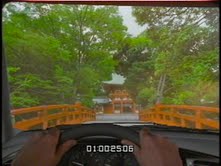
![]()
Index • |
Welcome • |
About
Us • |
21st Century • The Future |
World
Travel • Destinations |
Reviews • Books & Film |
Dreamscapes • Original Fiction |
Opinion
& Lifestyle • Politics & Living |
Film
Space • Movies in depth |
Kid's
Books • Reviews & stories |
The International Writers Magazine: Memoirs of A Mad Man
A Bridge To Enlightenment
• David Russell
What inspires a story? In this case, it may have been seeing pictures of this year’s last Cherry Blossoms in Tokyo. Or because my wife just completed her 12th year of being a docent at the Los Angles County Museum of Art
Japanese Pavilion.
Or maybe it was from reading about the Japanese economy in the newspaper. Whatever it was, it reminded me of a good tale. Actually, a lesson for life.
In the preface to my to-be-self-published book “A La Carte”; Tales of Food & Drink Digested From 55 Years Of International Travel; there are a number of Preface teasers to what follows in the book’s 30 country chapters. One teaser tells of my hosting dinner in a Tokyo Ginza Sushi Bar. It was Summer, 1993 and we were in Japan to shoot film sequences which later would become part of the Super Bowl Commercial introducing the New Ford Contour. Ford was calling Contour the “World Car” and literally our film team was traveling East to West around the world filming scenes for the 60-second spot. Before arriving in Tokyo, we had already filmed in a Paris park, at a glacier in the French Alps and in Holland where we were able to film a magnificent windmill. From Paris we had flew across Siberia to Tokyo where we planned to produce 2 scenes.
The first was a night shoot in the Ginza with all its colorful neon store lights and its heavy street traffic. Fortunately for us, it rained that night which greatly added visual drama to our scene..
The second location was to be at a Japanese monastery where filming was an everyday occurrence since many Japanese soap operas were made on its ground and buildings. When we arrived to scout the location, we all immediately fell in love with a very old, but beautifully preserved red lacquer bridge that crossed a small stream. Surrounding it was a myriad of heavy green tree foliage in full bloom.
For us, making the shoot looked easy. We just had to film the car crossing the bridge. On the other side, it would drive past a nearby building, then turn behind it and disappear. In this case, the camera was mounted on the car’s hood, so the viewer would see the entire panorama of what was ahead us and of course, the red lacquered wooden bridge. Later, with post-production magic, we would insert the driver’s hands, the steering wheel and windshield. (See finished Scene above).
But, just as we were prepared for Take 1, from out of the Monastery tore the Head Monk screaming “No. No. No.”.
Later, from our English speaking contact, we learned why the tumult. In 1920 the Emperor of Japan had driven over that bridge and no one else had been permitted to “drive” over it. To the Japanese, it was considered a sacred bridge and used only for foot traffic, bicycles and small carts. No cars. What that said to me immediately was that was a shot we were not going to get and with my American thinking, not being able to film the scene we wanted had me getting ready to pull the plug and look for somewhere equally as interesting.
But before I had time to call it quits, our contact Monk said to me, “Wait! Let me think about this.” And, off he wandered under the leafy trees. Ten minutes later he was back asking, “Can you push the car across the bridge?” Since our camera was mounted on the car hood, with our full crew, pushing the car would be no problem at all.
Quickly we agreed. Push it we did acfross the bridge, then drove off the other side. We got our shoot, a major contribution to the finished spot. In the final edit, after crossing the bridge, our turn behind the building, drove us without a cut or dissolve directly into a hot, sandy desert scene. To me personally, it was more than a great shot, it was also a learning experience I was able to apply time and again.
It also gave me greater appreciation for the differences in how people think, especially the differences between East and West. Our western get-it-done approach has us reaching for a quick answer, while our friendly meditating Monk found a better way by taking the time to look at the problem from prospectives we never would have considered.
To the temple rental fee I added a substantial donation to the Monastery for a location move we needed not make, plus “a great lesson learned” Leaving Tokyo, we were a happy crew, we had gotten 2 wonderful shots. Our next stop was in San Francisco to film with a helicopter passing the Golden Gate Bridge and then we moved down to the California desert where we made the scene which followed our red lacquer bridge shot.
Bottom line – and I can hear many of you asking, was it worth all the time, money and effort? The answer was a definite “’Yes”. Ford happily experienced
a presale of 600 Contours and 300 of Contour’s concept matching Mercury
Marquis.For me, it was also a happy ending to a once-in-a-lifetime adventure, with a priceless lesson learned. Facing hard decision thereafter, I learned to slow down and creatively look at all the alternative answers I could think of, before reaching a decisive decision. In the 17 years since that Tokyo visit, I can’t tell you how often that lesson has saved my day .
© David Russell <druss811@verizon.net> .
More comment

